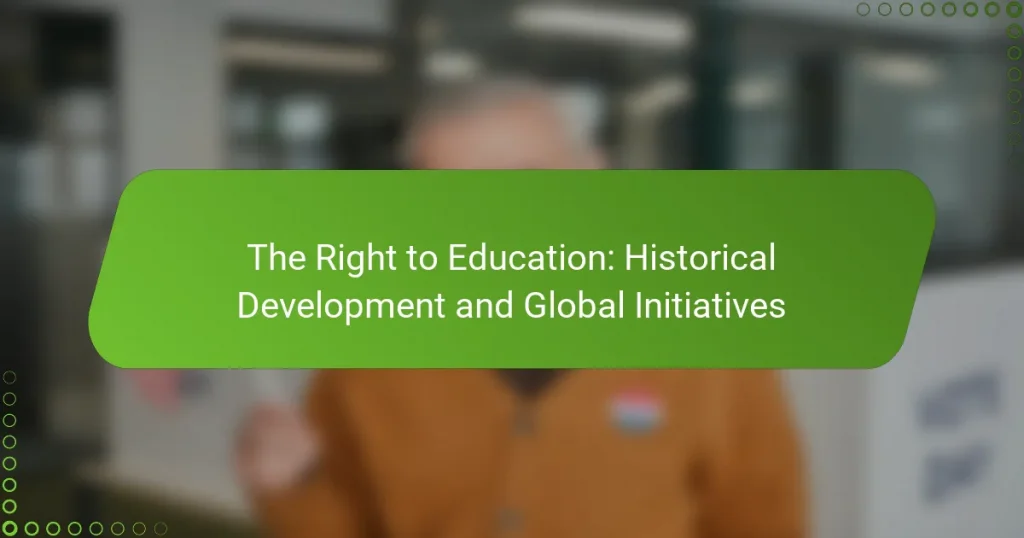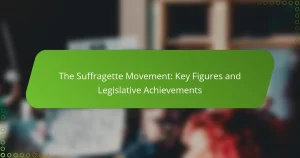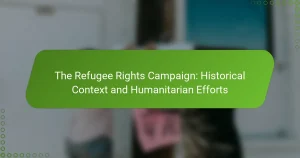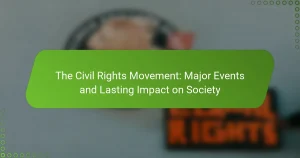The Right to Education is a fundamental human right that guarantees individuals access to education, recognized in international treaties like the Universal Declaration of Human Rights and the Convention on the Rights of the Child. This right ensures that education is available to all without discrimination, promoting both primary and secondary education as essential for personal and societal development. Despite this, UNESCO reports that over 260 million children worldwide remain out of school, underscoring ongoing challenges to achieving this right. The article explores the historical development of the Right to Education and highlights global initiatives aimed at ensuring free and compulsory education, particularly at the primary level, while emphasizing the necessity of quality education accessible to all.
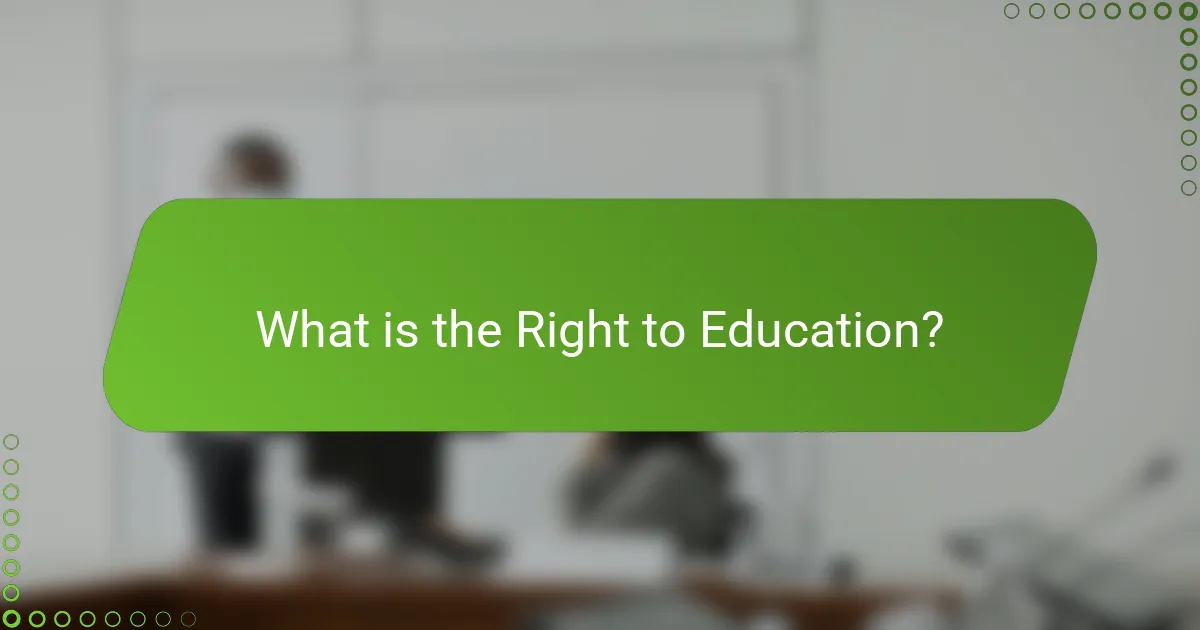
What is the Right to Education?
The Right to Education is a fundamental human right that guarantees individuals access to education. This right is recognized in various international treaties, such as the Universal Declaration of Human Rights and the Convention on the Rights of the Child. It ensures that every person has the opportunity to receive an education without discrimination. The Right to Education promotes both primary and secondary education as essential for personal and societal development. According to UNESCO, over 260 million children worldwide remain out of school, highlighting the ongoing challenges to this right. The right also includes provisions for free and compulsory education at the primary level. It emphasizes the importance of quality education that is accessible to all, regardless of background. The Right to Education is vital for fostering equality and empowering individuals in society.
How has the concept of the Right to Education evolved over time?
The concept of the Right to Education has evolved significantly since its inception. Initially, education was seen as a privilege for the elite. Over time, it transformed into a recognized human right. The Universal Declaration of Human Rights in 1948 marked a pivotal moment, stating that everyone has the right to education. This was further reinforced by the International Covenant on Economic, Social and Cultural Rights in 1966, which emphasized free primary education. In the late 20th century, global initiatives like the Education for All movement in 1990 aimed to ensure access to education for all children. Today, the Right to Education is enshrined in various national constitutions and international treaties, reflecting its importance in promoting equality and development.
What historical milestones have shaped the Right to Education?
The Right to Education has been shaped by several historical milestones. The Universal Declaration of Human Rights in 1948 established education as a fundamental human right. The Convention on the Rights of the Child in 1989 emphasized the right to education for all children. The Education for All initiative, launched in 1990, aimed to provide universal access to quality education. The Dakar Framework for Action in 2000 further committed nations to achieving education for all by 2015. In 2015, the Sustainable Development Goals included a specific target for inclusive and equitable quality education. These milestones collectively highlight the evolving recognition of education as a vital right.
How have different cultures influenced the understanding of the Right to Education?
Different cultures have significantly influenced the understanding of the Right to Education. Cultural values shape educational priorities and practices worldwide. For instance, in collectivist societies, education often emphasizes community and social responsibility. In contrast, individualistic cultures focus on personal achievement and self-expression in education.
Historical contexts also play a role. For example, ancient Greece valued education for civic participation, while Confucianism in China emphasized moral development and respect for authority. These cultural perspectives inform national education policies and curricula today.
Research shows that countries with diverse cultural backgrounds often adopt inclusive education models. These models accommodate various learning styles and perspectives, enhancing educational access. The Universal Declaration of Human Rights, adopted in 1948, reflects a global acknowledgment of education’s importance, influenced by diverse cultural insights.
Overall, cultural influences shape the interpretation and implementation of the Right to Education across different societies.
Why is the Right to Education considered a fundamental human right?
The Right to Education is considered a fundamental human right because it is essential for the exercise of other rights. Education empowers individuals to participate fully in society. It promotes personal development and social cohesion. The Universal Declaration of Human Rights, adopted in 1948, states that everyone has the right to education. Article 26 emphasizes that education should be free, at least in the elementary stages. This foundational principle is recognized in various international treaties, including the International Covenant on Economic, Social and Cultural Rights. Access to education is crucial for reducing poverty and inequality. It fosters informed citizenship and supports sustainable development.
What international agreements support the Right to Education?
The Right to Education is supported by several international agreements. The Universal Declaration of Human Rights (1948) states that everyone has the right to education. The International Covenant on Economic, Social and Cultural Rights (1966) further emphasizes the right to free primary education. The Convention on the Rights of the Child (1989) mandates access to education for all children. Additionally, the Dakar Framework for Action (2000) calls for universal access to quality education. These agreements collectively reinforce the global commitment to ensuring education as a fundamental human right.
How does the Right to Education impact individual and societal development?
The Right to Education significantly impacts both individual and societal development. It empowers individuals by providing access to knowledge and skills. This access leads to improved employment opportunities and higher income potential. Education fosters critical thinking and informed decision-making. Individuals with education are more likely to participate in civic activities.
At the societal level, education promotes economic growth and reduces poverty. Societies with higher education levels tend to have lower crime rates. Education also contributes to better health outcomes and increased life expectancy. According to UNESCO, every additional year of schooling can increase a person’s earnings by up to 10%.
Thus, the Right to Education is foundational for personal advancement and societal progress.
What are the key components of the Right to Education?
The key components of the Right to Education include accessibility, availability, acceptability, and adaptability. Accessibility ensures that education is physically and economically reachable for all individuals. Availability requires that sufficient educational institutions and resources are provided. Acceptability mandates that the education delivered meets quality standards and is culturally relevant. Adaptability allows education systems to be flexible and responsive to the needs of diverse populations. These components are recognized in international frameworks such as the Universal Declaration of Human Rights and the Convention on the Rights of the Child.
What types of education are encompassed by the Right to Education?
The Right to Education encompasses various types of education, including primary, secondary, and higher education. Primary education is fundamental and typically includes basic literacy and numeracy. Secondary education builds upon primary education and often prepares students for higher education or vocational training. Higher education includes universities and colleges, offering advanced academic and professional training. Additionally, the Right to Education supports inclusive education, ensuring access for marginalized groups. The Universal Declaration of Human Rights states that everyone has the right to education, highlighting its importance in fostering equality and development.
How does access to education vary across different regions?
Access to education varies significantly across different regions. In developed countries, such as those in North America and Western Europe, education is generally accessible and compulsory. High literacy rates and well-funded educational systems characterize these areas. In contrast, many developing regions, particularly in Sub-Saharan Africa and South Asia, face challenges. Limited infrastructure, poverty, and conflict hinder educational access in these regions. According to UNESCO, over 260 million children are out of school globally, with the highest numbers in these less developed areas. Gender disparities also exist, with girls often having less access to education in certain regions. In some Middle Eastern countries, political instability affects educational opportunities. Thus, regional differences in access to education stem from economic, social, and political factors.
What global initiatives promote the Right to Education?
Global initiatives that promote the Right to Education include UNESCO’s Global Education Monitoring Report and the Education for All (EFA) movement. UNESCO’s report monitors progress towards achieving education goals established by international agreements. The EFA movement, launched in 1990, aimed to provide quality basic education for all children, youth, and adults. Another significant initiative is the United Nations Sustainable Development Goal 4, which aims to ensure inclusive and equitable quality education. Additionally, the Global Partnership for Education mobilizes funding to support education in developing countries. These initiatives collectively work to eliminate barriers to education and ensure access for all.
What role do international organizations play in advancing the Right to Education?
International organizations play a crucial role in advancing the Right to Education. They establish global frameworks and standards that promote educational access and equity. Organizations like UNESCO advocate for inclusive education policies. They provide technical assistance to countries developing educational systems. These organizations also mobilize financial resources to support education initiatives. For example, the Global Partnership for Education has funded over 60 countries. This funding helps to improve educational infrastructure and teacher training. International organizations also conduct research to identify best practices in education. Their efforts contribute to policy development and reform worldwide.
How do national governments implement policies to support the Right to Education?
National governments implement policies to support the Right to Education through legislation, funding, and strategic planning. They establish laws that guarantee access to education for all children. These laws often align with international treaties like the Universal Declaration of Human Rights. Governments allocate budgets specifically for educational programs and infrastructure. They may also create initiatives to improve teacher training and curriculum development. Monitoring and evaluation mechanisms are often put in place to assess educational outcomes. For instance, UNESCO reports that countries with dedicated education policies see higher enrollment rates. Additionally, governments collaborate with NGOs to enhance educational access in underserved areas.
What challenges exist in achieving universal access to education?
Challenges in achieving universal access to education include financial barriers, infrastructural inadequacies, and socio-cultural factors. Financial barriers prevent families from affording education-related expenses. In many regions, schools lack adequate facilities and resources, hindering effective learning. Socio-cultural factors, such as gender discrimination and cultural norms, can restrict access for certain groups. According to UNESCO, over 260 million children are out of school globally, highlighting the scale of this issue. Additionally, conflict and instability in various regions disrupt educational systems. These challenges collectively impede the goal of universal education access.
What barriers prevent equitable access to education worldwide?
Barriers preventing equitable access to education worldwide include poverty, gender inequality, and lack of infrastructure. Poverty limits resources for families to afford education. Approximately 258 million children are out of school due to financial constraints. Gender inequality restricts girls’ access to education in many regions. In some countries, girls are less likely to attend school than boys. Lack of infrastructure affects rural and remote areas disproportionately. Many children in these areas travel long distances to reach schools. Additionally, conflict and political instability disrupt education systems. Over 75 million children are affected by crises, hindering their educational opportunities. These factors collectively create significant obstacles to achieving equitable education for all.
How do socio-economic factors influence the Right to Education?
Socio-economic factors significantly influence the Right to Education by determining access, quality, and equity in education systems. Families with higher income levels can afford better educational opportunities, including private schooling and tutoring. In contrast, low-income families often face barriers such as inadequate school facilities and lack of resources.
Research indicates that children from wealthier backgrounds are more likely to complete higher levels of education. A UNESCO report highlights that children in low-income households are at a greater risk of dropping out of school. Additionally, socio-economic status affects parental involvement, which is crucial for a child’s educational success.
Communities with higher poverty rates often have underfunded schools, leading to larger class sizes and lower teacher qualifications. This disparity creates a cycle of educational inequity, perpetuating socio-economic disadvantages. Thus, socio-economic factors play a critical role in shaping educational outcomes and access to the Right to Education.
What are the future directions for the Right to Education?
Future directions for the Right to Education include enhancing access, improving quality, and integrating technology. Access must expand to marginalized groups, ensuring inclusivity. Quality education requires updated curricula that reflect current knowledge and skills. Technology integration can facilitate remote learning and resource sharing. Policymakers must prioritize funding to address disparities in educational resources. Global collaboration is essential for sharing best practices and innovations. Monitoring and evaluation frameworks should be strengthened to assess progress and effectiveness. These directions aim to fulfill the commitment to universal education for all.
How can technology enhance access to education globally?
Technology enhances access to education globally by providing online learning platforms and resources. These platforms allow students from remote areas to access quality education. For instance, MOOCs (Massive Open Online Courses) offer courses from top universities worldwide. According to a report by the World Economic Forum, over 1.5 billion students were affected by school closures during the COVID-19 pandemic. Technology enabled many of these students to continue their education through online classes. Furthermore, mobile devices facilitate learning in regions with limited infrastructure. In 2021, UNESCO highlighted that digital tools could bridge educational gaps in underserved communities. Overall, technology democratizes education and makes it more inclusive.
What strategies can be employed to overcome existing challenges?
Implementing comprehensive policies is crucial to overcoming existing challenges in education. These policies should focus on increasing access to quality education for all demographics. Governments can allocate more funding to under-resourced schools. Training and supporting teachers enhances educational quality. Community engagement can raise awareness about the importance of education. Partnerships with NGOs can provide additional resources and support. Utilizing technology can bridge gaps in remote areas. Monitoring and evaluation of educational programs ensure effectiveness and accountability. Historical data shows that targeted interventions improve educational outcomes significantly.
What best practices can be adopted to promote the Right to Education effectively?
Adopting inclusive policies is a best practice to promote the Right to Education effectively. These policies should ensure access for marginalized groups, including girls and children with disabilities. Training teachers on inclusive education methods enhances the learning environment. Community engagement fosters local support and awareness about educational rights. Implementing monitoring systems tracks progress and identifies gaps in access. Governments should allocate adequate funding to education to sustain initiatives. Collaborating with NGOs can provide additional resources and expertise. Finally, raising public awareness through campaigns can mobilize support for education rights.
The Right to Education is a fundamental human right ensuring access to education for all individuals, as recognized in international treaties such as the Universal Declaration of Human Rights and the Convention on the Rights of the Child. This article explores the historical development of the Right to Education, highlighting key milestones and global initiatives that have shaped its evolution. It examines the impact of cultural influences, socio-economic factors, and the role of international organizations in promoting educational access. Additionally, the article addresses the challenges and barriers to achieving universal education and discusses future directions and best practices for enhancing the Right to Education globally.
